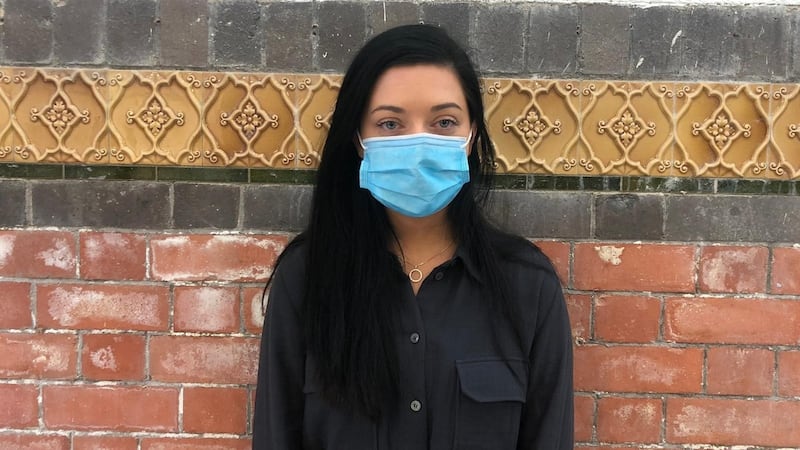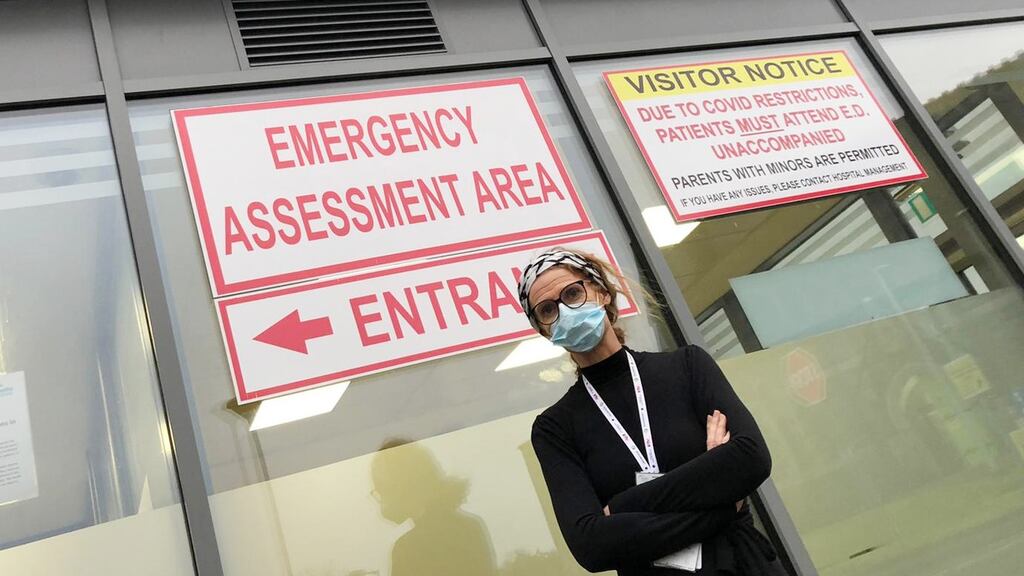A single storey, grey temporary building sits on the edge of the ambulance parking bay beside Mayo University Hospital (MUH) in Castlebar, with a wheelchair ramp running up to its door.
There are no signs outside to proclaim what function it provides, bar a yellow and black Covid-19 poster. In fact, it is the first place that people with the Covid-19 virus see when they arrive.
Some come by ambulance from their homes, at the request of their GP, but others simply walk in off the street. Everyone hopes they walk out again. Most do, some have not.
Hospital Report
Covid-19 has been "a life-changing event" for the 1,600 staff at the Mayo hospital, including 1,300 doctors and nurses, says hospital manager Catherine Donohoe.
Caring for people across Mayo, Sligo and Roscommon, the Castlebar hospital offers 24-hour emergency care and an intensive care unit. It is linked to a sister hospital in Galway for some specialist care.
With 300 beds for patients with all illnesses, it has room on its grounds to add more than 20 more emergency beds, while 40 more can be found in the Sacred Heart hospital nearby on Pontoon Road in the town.
This week, staff explained how they have managed the crisis since the third Covid wave hit the country from late December, one that is only now showing signs of abating.
That surge hit Mayo particularly hard, says Donohoe, with some regions, such as Belmullet, briefly topping national and international charts.
“We thought it was going to be probably a doubling of where we were in the first wave, which meant that we would be around 60, maybe 70, Covid-positive patents at any given time.
“But what came was, like, our highest number. . . we had four and a half wards allocated to Covid instead of two. We had an all-time high, I think it was 170, of Covid-positive patients,” she says.
In early January, it had 40 such patients. “We were having families coming in together, not individuals. Husbands and wives, with a teenage child, [were] arriving,” she went on.
The ones who came needed hospital care: “Patients were coming in on day nine, or day 10 [of their infection] very unwell and continued to deteriorate,” she went on.
That is different to the previous waves: “In the first, they were deteriorating on day five and day seven, and were either requiring critical care, or were starting to recover, around day 12 or 14.”
Inside the Covid-19 building, there are five nurses, three doctors, a healthcare assistant and a porter working out of a reception room and six separate examination rooms, with full PPE precautions. Laura Melvin is the CNM1 (clinical nurse manager 1), who co-ordinates the area. It can be difficult seeing patients so unwell or deteriorating rapidly, she says.
“I had a patient in his 60s, who was very fit, very well and cycled five miles a day,” she says. “He walked in and said I feel unwell. His oxygen levels were low, much lower than normal. . . [and] he deteriorated just like that . . .”
With little time for staff to intervene, the man was put on a ventilator and he pulled through. “He’s gone home now,” says Melvin. “So that’s a good story.”
‘They feel alone’
Unlike last March or April, patients are frightened because, after a year of the pandemic, they know now what can happen: “[They] are terrified when they come in,” she says.
“Wearing all the PPE you have to really, really try hard to reassure them and be calm; tell them what you’re going to do, explain to them, take the stress out of their eyes. They’ll grab your hand and say I’m really scared.
“You have to be very, very strong and quick in what you are deciding what the patient needs. It’s almost military but calm. It has to be calm,” she tells The Irish Times.

“We have to support them and say, ‘Do you want me to call someone? Are you OK?’ We have to be very conscious that they feel alone and we don’t want them to feel alone.”
The third wave is different, too, says Melvin, because it is bringing new types of patients, including children and pregnant women: “To see an increase of Covid in pregnant women is quite frightening.
“We had one woman who was pregnant, was Covid positive and was ventilated and then they delivered her baby while ventilated. That was a shocking moment.” Mother and baby are now well.
Mary Neary, runs one of the hospital's four 33-bed Covid wards, staffed by five nurses, two or three healthcare assistants, physio and occupational therapists and a ward clerk.
She works a 12-hour shift. “Sometimes I feel I work longer. That’s alright. It’s just the way it is. Sometimes we lose the battle. I’m a long time in nursing and I really feel this is the hardest time I’ve had.
“It’s not the hours, it’s the intensity . . . It’s day in, day out. It’s going on and on. You’re working in PPE all the time and that’s draining,” she says, especially when trying to reassure patients or their families.
“Wearing PPE it’s hard to talk to patients and families. It’s scary for them. There is a barrier there and it’s frightening for the patients. There’s so much psychological reassurance to be done.”
No guarantees
Known to her colleagues as "the last man standing", because she is the hospital's longest-serving physician, Dr Fionnuala Lavin is a cardiologist and critical care consultant.
Working with colleagues, including a consultant anaesthetist, a respiratory nurse and specialised respiratory physios, Lavin does thrice-daily ward rounds, deciding where patients are best kept, or if they need to go to ICU.
Patients may be given oxygen via a small nebulizer mask. If that is not enough, oxygen is delivered under greater pressure through a more tightly-fitting, and larger, face mask. The next stage could be ICU.
“You have to make the decision: are they going to benefit from full ventilation and is it in their interest to put them on a ventilator?” she says. “You have to [ask] is the patient going to tolerate [it]?
“Could they die during [it]? Will it benefit their lungs and will they come off ventilation? They are the questions. Is it going to alter their prognosis, or are you better to try non-invasive [treatment]?”
Thinking of one patient, a late middle-aged woman who is conscious and alert but whose lungs are struggling, Lavin says the struggles are worsened by the gap forced by PPC, and by the isolation of the patient from loved ones.
“We have to escalate her oxygen,” she says. “It’s very difficult for [a woman of that age] to accept that if we don’t put her on a ventilator, she’s going to die. And because she’s in a single room, she’s completely isolated.
“I have to go and ring her daughter and I have to break bad news over the phone. Nobody likes to break bad news over the phone. Normally I would bring somebody into the room, have someone with them.
“So I break the bad news. I tell her that we’re going to do everything. And then I ask her if she has any questions and she says. ‘I only have one: Is my mother going to survive this?’ And what can you say? Nobody can give a guarantee.”
‘It is high risk’
A 16-year veteran in the hospital, Dr Michelle Duggan, a consultant anaesthetist in the hospital's operating theatre and ICU, deals with patients who are facing the toughest struggles.
Brought into ICU for ventilation, unconscious patients are proned (turned on to their stomachs to ease pressure on the lungs). A tube is first put through the vocal cords into the lungs, she explains. “You’re are completely relaxed and sedated and the machine does the work for you at that point. You are deeply unconscious.
“It is high risk. It is aerosol-generating and so we put full PPE on,” she says, adding that a minimum number of people stay to avoid exposing “too many” – “a consultant, like myself, maybe one of my trainees, and a specialised ICU nurse”.
Patients that respond generally do so within a few days, but they could be in ICU for weeks, sometimes with ventilation via a tracheotomy, she says.
But ventilators do not solve every problem: “[They] are great and fantastic but sometimes you just cannot oxygenate a patient no matter what you do; the lungs become so fibrotic and stiff and it becomes impossible.”
Difficult choices are then faced, including a decision to cease treatment, depending on how other organs are doing, says Dr Duggan. “Is it a single organ failure, just the lungs, or multi-organ failure?”
Patients with a chance are transferred. Sometimes, there are no options left, leaving Dr Duggan, her colleagues and the patient’s families with heart-wrenching decisions.
Such experiences, especially during this latest wave, have left MUH medics and staff shocked: “It’s a very frightening disease,” says Dr Duggan. “I would be frightened of getting Covid myself. Don’t underestimate it.
“No matter how fit and healthy you are, it’s very contagious and seems to have very detrimental effects on age groups that you wouldn’t expect it to have,” she sys.
One year on, hospital manager Catherine Donohoe reflects: “The shining light is how well people have worked together. Like every walk of life, Covid has brought out the best in most people and the worst in some people.
“But to see the way the staff work. My shining light is that I have faith in the people who work in the system,” she says, with pride glinting in her eyes.














